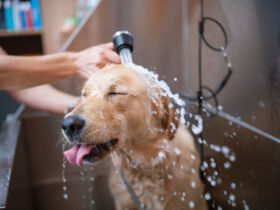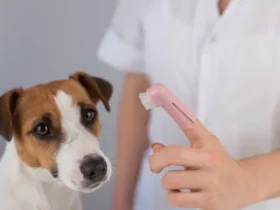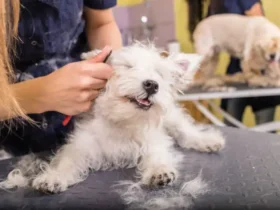If you’ve ever owned or spent time with a Samoyed, you know that these fluffy, cloud-like dogs are known for their beautiful, thick coats. However, with great fluff comes great responsibility, especially when a Samoyed begins to “blow” her coat. This natural shedding process can be overwhelming, and you might be shocked at just how much fur comes off during this time. Let’s dive into what it means for a Samoyed to blow her coat, why it happens, and how you can manage the mountains of fur that will inevitably take over your home.
1. What Does It Mean to “Blow” a Coat?
- Definition: Blowing the coat is a term used to describe the seasonal shedding process where a double-coated dog, like a Samoyed, sheds its undercoat.
- Why It Happens: This process typically occurs twice a year, usually in the spring and fall, as the dog’s body prepares for a change in temperature. In the spring, the heavier winter coat is shed to make way for a lighter summer coat, while in the fall, the process reverses.
- Campbell’s Insight: “Blowing the coat is a natural process that helps regulate a dog’s body temperature. However, for owners, it can mean dealing with a lot of fur.”
2. Understanding the Samoyed Coat
- Double-Coated Breed: Samoyeds have a double coat, consisting of a dense, soft undercoat and a longer, coarser topcoat. The undercoat is what sheds during the blowing process.
- Purpose of the Coat: The undercoat provides insulation, keeping the dog warm in cold weather, while the topcoat protects against moisture and dirt.
- Impact on Shedding: Because of the thick undercoat, Samoyeds shed a significant amount of fur during the blowing period. It’s not uncommon to find clumps of fur around your home, and regular grooming becomes essential.
3. How Much Fur Are We Talking About?
- Volume of Shedding: The amount of fur a Samoyed sheds during this period can be astounding. Some owners compare it to having a second dog’s worth of fur in the house!
- Visible Signs: You’ll notice tufts of fur falling out in large quantities, often accumulating in corners or on furniture. Regular cleaning is necessary to manage the mess.
- Campbell’s Observation: “During peak shedding times, it can seem like your Samoyed is leaving a trail of fur wherever she goes. Don’t be alarmed—this is completely normal.”
4. Preparing for the Coat Blow
- Grooming Tools: Invest in high-quality grooming tools such as an undercoat rake, a slicker brush, and a de-shedding tool. These tools will help remove loose fur and prevent it from spreading all over your home.
- Establish a Routine: Regular brushing is key during the coat-blowing period. Aim to brush your Samoyed daily to keep shedding under control.
- Bathing: A warm bath can help loosen the fur, making it easier to brush out. Follow the bath with a thorough brushing session to remove as much loose fur as possible.
- Campbell’s Tip: “Be patient and gentle during grooming. Your dog’s skin can be sensitive during shedding, so take care to avoid irritation.”
5. Managing the Shedding in Your Home
- Cleaning Strategies:
- Vacuum Regularly: A high-quality vacuum with a pet hair attachment is essential for keeping your home fur-free. Vacuuming daily during shedding season can help manage the fur.
- Lint Rollers: Keep lint rollers handy in every room to quickly remove fur from clothing and furniture.
- Air Purifiers: Consider using an air purifier to reduce the amount of airborne fur and dander.
- Protecting Furniture: Use furniture covers or blankets to protect your couches and chairs from fur accumulation. These can be easily washed to remove fur.
- Campbell’s Advice: “Managing the fur at home requires diligence. Stay on top of cleaning to prevent fur from taking over your living space.”
6. Health Considerations During Shedding
- Skin and Coat Health: Monitor your Samoyed’s skin and coat for signs of irritation or infection. Excessive shedding can sometimes lead to hotspots or other skin issues.
- Diet and Supplements: A healthy diet rich in omega-3 and omega-6 fatty acids can promote a healthy coat and reduce excessive shedding. Consider adding fish oil supplements to your dog’s diet, but consult with your vet first.
- Hydration: Ensure your Samoyed stays hydrated, as dehydration can lead to dry skin and increased shedding.
- Campbell’s Insight: “A healthy coat starts from within. Proper nutrition and hydration are crucial during shedding season.”
7. Grooming During the Coat Blow
- Brushing Techniques:
- Undercoat Rake: Start with an undercoat rake to remove loose undercoat fur. This tool is specifically designed to reach through the topcoat and effectively remove the dense undercoat.
- Slicker Brush: Follow up with a slicker brush to smooth the topcoat and remove any remaining loose fur.
- De-Shedding Tool: Use a de-shedding tool like the Furminator to tackle stubborn areas where the fur is thickest.
- Frequency: Daily brushing is recommended during the coat-blowing period. Each session can last 15-30 minutes, depending on the amount of fur your dog is shedding.
- Campbell’s Recommendation: “Don’t rush the grooming process. Taking your time ensures you remove as much loose fur as possible and keeps your dog comfortable.”
8. When to Seek Professional Help
- Professional Grooming: If the shedding becomes overwhelming or if you’re struggling to keep up with the fur, consider taking your Samoyed to a professional groomer. They have the tools and expertise to handle heavy shedding.
- Grooming Frequency: Some owners opt for professional grooming every 4-6 weeks during shedding season to help manage the fur.
- Campbell’s Suggestion: “Professional groomers can make a significant difference, especially during the peak of shedding season. Don’t hesitate to seek help if needed.”
9. Maintaining a Clean and Comfortable Environment
- Comfort for Your Dog: Ensure your Samoyed has a comfortable place to rest during the shedding process. The shedding can be exhausting for them, so providing a clean, fur-free bed is important.
- Reducing Stress: Shedding can be stressful for your dog. Use calming products, such as anxiety wraps or lavender sprays, to help reduce their stress levels.
- Campbell’s Note: “A comfortable and stress-free environment can make the shedding process easier for both you and your dog.”
10. The Emotional Side of Shedding
- Understanding Your Dog’s Needs: Shedding can be uncomfortable for your Samoyed. Be patient and understanding as they go through this natural process.
- Bonding Opportunity: Use grooming sessions as a time to bond with your dog. Gentle brushing and care can strengthen your relationship and help your dog feel more at ease.
- Campbell’s Perspective: “Shedding season can be a challenging time, but it’s also an opportunity to connect with your dog on a deeper level.”
Conclusion
Dealing with a Samoyed who’s blowing her coat can be a daunting experience, especially if you’re not prepared for the sheer volume of fur that will come off. However, with the right tools, techniques, and mindset, you can manage the shedding process and keep your home clean. Remember that this is a natural and necessary part of your Samoyed’s life, and with a little patience and care, you’ll get through it together.
By following Veterinarian Courtney Campbell’s expert advice, you’ll be better equipped to handle the fur explosion that comes with owning a Samoyed. From grooming tips to cleaning strategies, these insights will help you navigate shedding season with confidence and keep your fluffy friend looking and feeling their best.











Leave a Reply